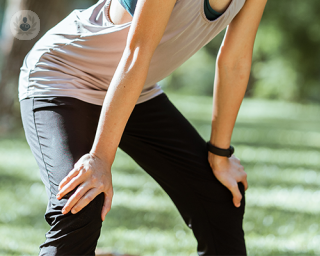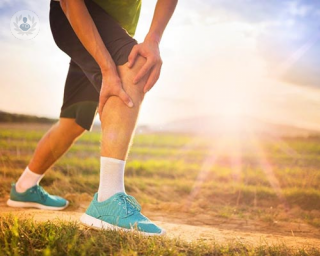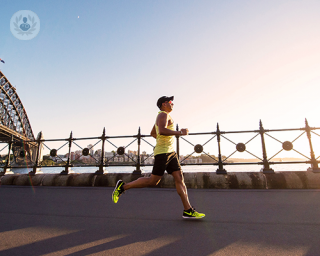Knee
Mr Cristian Nita - Orthopaedic surgery
Created on: 11-13-2012
Updated on: 08-09-2023
Edited by: Sophie Kennedy
What is the knee?
The knee is the central joint of the legs. It is formed by the meeting of two important bones: the femur and the tibia, and it joins the thigh and the lower leg. Inside the knee is a small bone called the patella or kneecap, which articulates with the anterior and inferior part of the femur.
The knee also houses two fibrocartilage discs, the menisci, and it is surrounded by a joint capsule and ligaments, which give it stability. The main ligaments are the external lateral ligament, the internal lateral ligament, the anterior cruciate ligament and the posterior cruciate ligament. Important muscles surround the knee to allow for flexibility and extension movements of the knee and leg.

Knee function
The knee supports most of our body weight when standing. The main movement of the knee is flexion-extension, although it can also rotate slightly when flexed.
Pathologies of the knee
The knee is vulnerable to serious injury from impact and trauma, usually the result of sports injuries. Osteoarthritis is common in older people and can be very disabling. The most frequent knee injuries are:
- Simple contusions : minor trauma without damage to the main structures of the joint (meniscus, bone or ligaments). These are considered benign, without complications, and are usually resolved in a short time using conservative measures such as anti-inflammatories, rest and ice applied to the joint.
- Ligament and meniscus injuries : these are common injuries in sport, as they cause tension in the joint. The most frequent injuries are torn menisci, lateral ligaments and cruciate ligaments.
- Tendon injuries : the tendons that suffer the most serious injuries are the quadriceps tendon, patellar tendon, goosefoot tendon, and the tendon of the popliteus muscle.
In addition, fractures can occur in the lower femur, upper tibia, or kneecap. They are generally complex fractures that can affect several bones, ligaments and the menisci and are usually caused by severe trauma. Dislocation, which is considered to be any injury that causes a permanent loss of contact between the joint surfaces, can also affect the knee.
The following conditions can also affect the knee:
- Joint effusion : the joint space usually contains synovial fluid, which serves to nourish the cartilage and provide lubrication, thus reducing friction of the joint and consequent wear. An excess of this fluid leads to joint effusion, which causes pain and an inability to move the knee.
- Osteoarthritis and arthritis: this condition affects more women than men and generally occurs from the age of 50 onwards.
- Osgood-Schlatter disease : this affects the tibial cartilage, causing pain during exercise. It improves with rest.
- Chondromalacia patella : this is common in young people and sportspersons. It is the degeneration of the cartilage between the kneecap and the femur.
- Hoffa's disease : chronic inflammation of the area of fat behind the patellar tendon and under the kneecap.
- Baker's cyst: this is a lump that occurs on the back of the knee due to chronic inflammatory processes and increased production of synovial fluid.
- Bursitis: the knee has several fluid-filled sacs or bursae, which are particularly vulnerable to repeated trauma. They can cause chronic inflammation.
Treatments for knee problems
Treatment for knee injuries will depend on the type and severity of the injury. First of all, you must follow the "PRICE" protocol: Protection, Rest, Ice, Compression and Elevation. To prevent further damage to the knee after injury you should not apply heat, not drink alcohol, not run or do any other exercise, and not massage the injured knee, as this can cause further swelling.
Anti-inflammatory drugs may help with mild to moderate pain. If the pain becomes intense, a doctor may prescribe a stronger pain reliever. If the injury is severe, the specialist may recommend physiotherapy and will design a rehabilitation exercise programme that is appropriate for you and the type of injury.
In some cases, the injury may require surgery; for example, if you have torn the external lateral ligament, if you have damaged the anterior cruciate ligament and do a lot of sport, or if you have torn the internal lateral ligament, which will require reconstructive surgery. Surgery is also indicated if the injury involves several ligaments or if you have torn a patellar tendon.

















